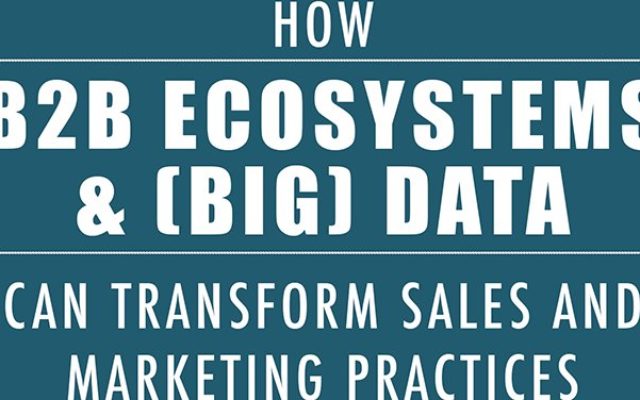Managing your relationships with customers, suppliers, and partners and constantly improving their experience is a proven way to build a sustainable and profitable business, and contrary to popular assumption, this doesn’t apply to B2C businesses only. With 89% of B2B research studies using the internet during the internet research process, improved collaboration to deepen existing customer relationships and build new ones is vital to running a successful B2B business as well.
This increasing need for collaboration has led to the development of digital ecosystems. Players like Apple and Google present an interesting case for how B2C ecosystems work. Consider Apple, which is primarily a B2C tech vendor, but it has built a new smart business model that pulls together technologies from multiple domains and combines them to form a solution that wins buyers acceptance. Amazon, Facebook, and Google are working on a similar kind of business model as well.
So, considering the examples of these tech giants, one can suggest that in this era of personalized customer experiences, B2B ecosystems are no longer an add-on; instead, they have become a necessity for progressive B2B businesses.
Offering valuable insights into customer journey, B2B ecosystems work by segmenting and targeting your audience, allowing you to deliver personalized content to clients across all channels. What’s more, with B2B ecosystems, you can improve customer engagement and develop more profitable relationships by optimizing content on various touch points that combine to form your customer journey roadmap. So, the secret to success for B2B businesses lies in collaboration and sharing of (big) data to improve customer experience and engagement.
What is a B2B Ecosystem?
The core concept of B2B ecosystems comes from the natural ecosystem, a biological community comprising of living and non-living things. The essential feature of any ecosystem is interdependence. For example, herbivorous animals like sheep and goats feed on plants, which in turn need water, sunlight, and minerals from soil to grow.
The same concept applies to a B2B ecosystem as well, which is a community of systems working together to serve the needs of customers. Just like a natural ecosystem, a B2B ecosystem has several different components, such as:
- Enterprise Resource Planning System
- Customer Relationship Management System
- Product Information Management System
- Order Management System
- Marketing Automation System
The list is non-exhaustive and may contain various other types of systems based on the precise needs and scope of a B2B business.
The Role of B2B Ecosystems in Sales and Marketing
While B2B marketing practices have changed considerably over the past few years, marketing goals have remained the same — more leads, more sales, and more revenue. However, the explosion of new marketing channels and the changing demographics of B2B customers have posed certain challenges to B2B marketers which can only be overcome through the use of unified marketing framework — a framework that connects the marketing and sales department of a business with other ‘systems’ in the ecosystem for improved collaboration and sharing of (big) data.
The customer-related data of a B2B business reside in multiple systems, such as ERP, CMS, POS, PIM, Order Management, Sales Enablement, etc. To best serve the customer with a cohesive experience across all marketing channels and touch points of the customer journey, these systems must be interconnected to form a B2B ecosystem.
Leveraging on a well-connected and well-equipped B2B ecosystem, marketers can:
- Use Customer Insights to Cross-Sell — Using the previously gathered information, B2B businesses can improvise their campaigns, as well as use the customer insights to pitch products/services that customers are most likely to invest in.
- Offer a Personalized Experience — For any B2B business, an ecommerce website is their most important marketing tool. Utilizing data made available from collaboration, businesses can deliver a more relevant and engaging experience to the customer from their very first visit.
- Optimize the Order and Reorder Processes — Using the information available about the customer and their previous purchases, businesses can optimize the order value and order frequency.
- Better Manage Content — Access to data residing in the content management system, markets can reuse it for different devices and across multiple channels, which in turn can help optimize the content marketing strategy to generate more leads.
- Facilitate Lead Nurturing — Using a marketing automation tool, businesses can track and analyze the behavioral data of customers to identify and work on the leads that are likely to nurture into a customer more quickly.
Role of Leadership in the Development of a B2B Ecosystem
The planning and development of a B2B ecosystem is a process that involves virtually all systems and departments of a B2B system. Therefore, in order to facilitate its implementation, commitment of senior-level management is of utmost important, particularly the Chief Information Officers have an important role to play in the process.
Since a true collaborative ecosystem goes beyond the organizational boundaries, it requires an enterprise to invest in multiple technology solutions and collaborate with multiple partners, suppliers, and customers. As a result, the decision to plan and implement a B2B ecosystem requires long-term commitment of organizational leaders.
B2B Ecosystems as a Source of Innovations
Just like people networks, B2B ecosystems can also serve as a source of innovation. Consider Proctor & Gamble. The company leverages on its external networks to crowdsource new ideas, and as a result, possesses this unique ability to solve problems in collaboration with the members of its business network than it could do on its own.
The same applies to B2B ecosystems as well. Using B2B ecosystems, sales and marketing can collaborate with other functions of the business to have a real-time access to the latest customer information. Furthermore, collaboration with extended workforce, customers, and suppliers can offer B2B businesses access to information in areas where they cannot be physically present.
Internet of Things (IoT) by SAP and Cloud28+ are the two primary examples of B2B ecosystems being used by businesses today. In addition to this, collaboration solutions by Lithium and Jive also provided B2B businesses with a way to improve their collaboration with suppliers, business partners, and customers to develop a B2B ecosystem that offers them greater access to data and improve visibility and control over their customer journey and experiences.
To conclude, collaboration is the lifeblood of businesses and it can be achieved best with the use of technological solutions like Cloud28+ that are designed to facilitate and accelerate enterprise cloud adoption and organization-wide collaboration.
What is your opinion about Eco Systems and use of (big) data? Let us know what you think.
Article by channel:
Everything you need to know about Digital Transformation
The best articles, news and events direct to your inbox
Read more articles tagged: Featured









